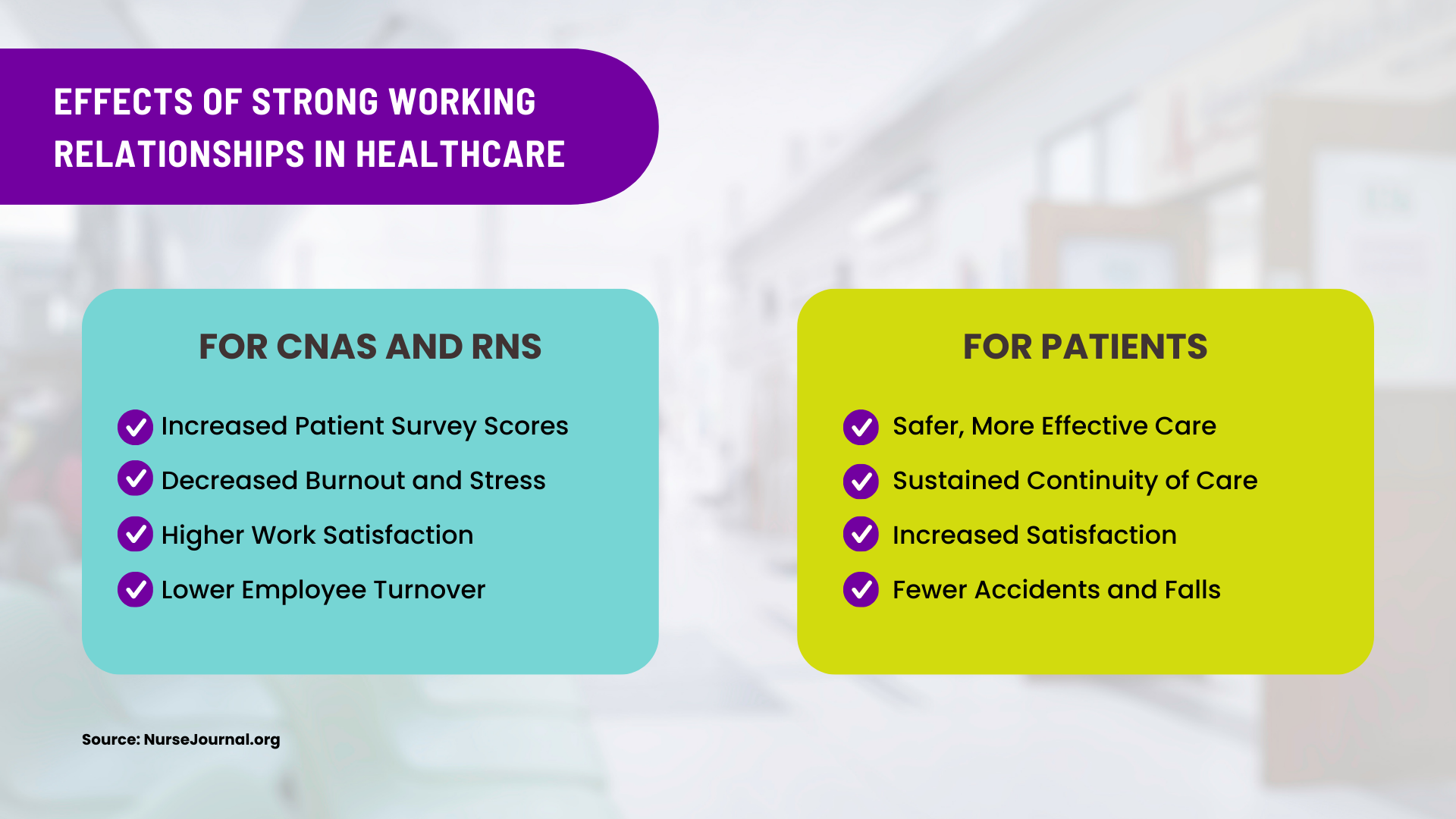Collaboration in Healthcare: How CNAs and RNs Can Work Better Together

Collaboration among individuals has led to some amazing feats. Consider NASA's Apollo Program from 1961 to 1972. Scientists, engineers, astronauts, researchers, and contractors all came together to achieve the goal of landing humans on the Moon. Now, think about how collaboration in healthcare impacts the level of care patients receive.

Certified nursing assistants (CNAs) and registered nurses (RNs) are part of the same team and should work towards the same goal, providing the best possible care to patients. Yet, there are so many stories of CNAs and RNs not seeing eye to eye.
To help put it in perspective, consider the East Coast-West Coast hip-hop rivalry between Tupac and Biggie. We all know how that turned out. Or what about Katy Perry and Taylor Swift feuding over backup dancers? Only their feud resulted in a happy ending. Both publicly reconciled in 2019 and have since expressed mutual respect.
8 Contributors to Patient Care Optimization
Collaboration between CNAs and RNs is essential in providing high-quality patient care and maintaining a smooth, efficient healthcare environment and positive work culture. However, such cooperation goes beyond RNs answering an equal amount of call bells and giving care when CNAs are working short.
Here's what it's really about:
1. Patient Safety
Patient safety should always be a priority. CNAs, who often have direct and continuous contact with patients, can communicate important information to RNs regarding changes in a patient's condition, response to treatment, or any concerns. RNs, with their advanced training, can then make informed decisions to address these issues promptly.
2. Continuity of Care
CNAs provide vital support in carrying out daily care activities, and effective communication strategies between CNAs and RNs ensure that important information about a patient's needs, preferences, and progress is shared seamlessly throughout shifts and changes in staffing.
3. Changing Conditions
CNAs are often the first to notice changes in a patient's condition or behavior. Collaborating effectively with RNs allows CNAs to report these observations promptly. RNs can then assess the situation, intervene as needed, and prevent potential complications or deterioration in the patient's health.
4. Resource Utilization
Collaboration in healthcare helps allocate resources efficiently. CNAs, who are involved in direct patient care, can communicate with RNs to ensure that resources, such as medications, equipment, and staffing, are utilized effectively to meet the needs of patients and maintain a safe care environment.
5. Patient Preferences
CNAs often spend more time with patients and can better understand their preferences, habits, and needs. Effective collaboration ensures that RNs receive this valuable information, allowing them to tailor care plans to meet each patient's needs and preferences.
6. Task Delegation and Support
RNs can delegate specific tasks to CNAs based on their training and scope of practice, allowing RNs to focus on more complex aspects of patient care. Effective collaboration involves clear communication about task delegation, ensuring that CNAs have the necessary information and support to carry out delegated responsibilities.
7. Team Morale
A collaborative and supportive work environment contributes to enhanced team morale. When CNAs and RNs work well together, there is a positive impact on the overall workplace culture, fostering a sense of teamwork, mutual respect, and shared responsibility for patient outcomes.
8. Efficient Workflow
When CNAs and RNs work collaboratively, they streamline their workflow, creating efficiency that's crucial in providing timely and responsive patient care in busy healthcare settings.
It helps to remember the roles and responsibilities CNAs and RNs play in patient care so there aren’t unrealistic expectations between parties.

How to Develop Effective Communication Strategies
No matter your occupation or place of employment, effective communication is vital to success. Why? Good communication boosts morale, engagement, productivity, and satisfaction.
Unfortunately, being an effective communicator takes a lot of work because not everyone communicates the same. Cultural backgrounds, gender, temperament, and how we're raised all influence how we communicate with others. That's why you may say one thing, but the person on the receiving end hears something different.
Effective communication, however, involves more than just an exchange of information. You must understand the intention and emotions behind it. Respect for the other person has to be the basis and must come across in our communications. After all, it's how we connect, build trust, and ensure others feel heard.
The good news, however, is that everyone can make changes to communicate effectively. For starters, it's essential to understand your communication style. Ask yourself the following:
Do I ramble or get right to the point?
Do I interrupt others or roll my eyes?
Do my conversations typically build or burn bridges?
While most of us don't use a single communication style in every interaction, we generally apply one of these four communication styles:
1. Passive Communicators
Passive communication is when you avoid saying what you think and feel. You have a lot of people-pleasing tendencies and ignore your needs. You sometimes allow others to walk over you rather than stand up for yourself. You look down instead of making eye contact with others and can often be excessively apologetic. An example statement would be I'm okay with whatever you want.
2. Aggressive Communicators
Aggressive communication is when you express your feelings and opinions strongly and as they occur. You might raise your voice or criticize others when you are upset. You might act defensively and not pay attention to what you're saying. An example statement would be get over it.
3. Passive-Aggressive Communicators
Passive-aggressive communication is when you appear passive on the surface but subtly act out anger. You might exert control over others through sarcasm and indirect contact or have limited consideration for the rights, needs, or feelings of others. An example would be giving the silent treatment.
4. Assertive Communicators
Assertive communication is when you're direct and honest about your thoughts and feelings. You also respect the feelings, ideas, and needs of others while asserting your own. You make eye contact and present relaxed gestures. Unfortunately, others often misinterpret assertive behavior as aggressive. An example statement would be I need for you to do.
As you can probably guess, assertive communication will lead you to successful, long-term relationships. And remember that effective communication is also about being an active listener.
Now what? If you feel like your communication skills need improvement, here are 4 tips:
Think Things Through: Why are you communicating? Who are you communicating with? What's your end goal?
Make Things Easy: People are busy, so don't make them work too hard to understand what you're saying and what you need them to do. However, you don't want to come across as condescending or dumb things down.
Practice and Reflect: Think about what goes well and what doesn't in your daily communications. Consider how you might do things differently in the future.
Seek Feedback: Ask people you trust to rate your communication skills to identify what you should start and stop doing when communicating with others.

How to Contribute to a Positive Work Culture
Whether you're a CNA or RN, it's everyone's responsibility to promote a positive work culture. Your gratitude and positive attitude can make the nursing unit or long-term care facility a delightful place to work.
Everyone has personal problems, so do your best to leave yours at home. Don’t take your stress out on others. Confide with your nurse besties during breaks or after work if you need to talk about things.
Approach Disrespect With Grace
It's not okay for someone to speak rudely or treat you in a disrespectful manner in the workplace. Here are some actions you might consider:
Ask yourself if you contributed to the situation.
Don't take it personally (this helps you control your emotional reaction).
Verbally acknowledge the disrespect, asking the person to repeat what they just said (this gives them pause to reconsider their voice and tone).
Maintain a respectful body stance and tone of voice.
Remove yourself from the situation to give the speaker time to cool off. Then, return to them later and ask to speak with them privately.
If you're treated poorly and can't reach a resolution, contact your nurse supervisor or employer (if you work for an outside company like ShiftMed).
Commit to Building Trust and Respect
Collaboration and communication are built on a foundation of trust and respect. These two elements define the quality and safety of patient care—and require the participation of both CNAs and RNs.
Building trust and respect is intentional, and we can all learn how. Here are some trust and respect-building behaviors:
Focus on what your colleagues are saying.
Ask for feedback on your suggestions.
Be mindful of your non-verbal behaviors.
Give positive feedback whenever possible.
Perform Random Acts of Kindness
Choose to be happy and kind at work. Compliment a colleague for a job well done, and remember to thank others when they lend you a hand. Bring in treats every once in a while. After all, who doesn't love a surprise donut or bagel before starting a shift?
Collaboration in Healthcare Conclusion
Effective collaboration in healthcare revolves around good communication, trust, respect, and a positive attitude. Remembering that every healthcare team member is valuable and contributes to quality patient care is also important. When CNAs and RNs can successfully work together, they're doing what's best for the patient, and that's what being in healthcare is all about.
Alice Blackmore, MN, RN, Content Writer
Alice is a registered nurse and healthcare writer. She has more than 20 years of nursing experience, which ranges from labor and delivery to long-term care, with pediatrics, community nursing, and critical care sandwiched in the middle.